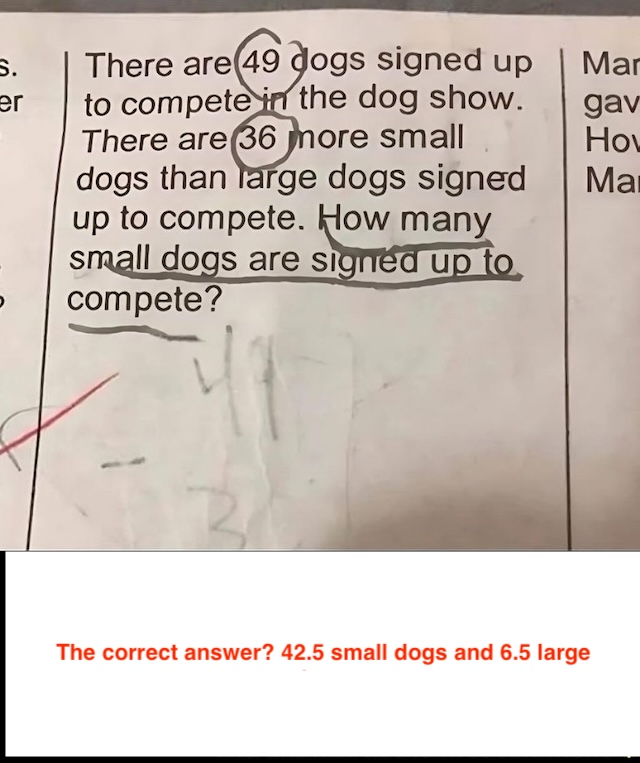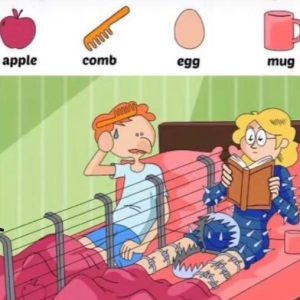At first glance, it’s just a kid’s math problem. The kind of thing you’d expect to breeze through while sipping your morning coffee. But when this second-grade question started making the rounds online, it quickly turned into an internet-wide facepalm. Because spoiler alert: the answer doesn’t make a whole lot of real-world sense—even though the math checks out.
So, what’s the question that made both parents and teachers scratch their heads? Let’s break it down, step by step, and see where things go sideways.

The Homework That Went Viral
Here’s how the math puzzle reads:
“There are 49 dogs signed up for a dog show. There are 36 more small dogs than large dogs. How many small dogs are signed up to compete?”
Sounds simple enough, right?
Except it’s not. People all over social media started sharing their confusion, wondering how something meant for an 8-year-old could be so baffling. Turns out, the devil’s in the details—and in this case, in the numbers.
Where Most People Slip Up
Here’s where this problem throws people off. You’re told there are 49 dogs in total, and that there are 36 more small dogs than large ones. That “more than” part tricks the brain into thinking this should be an easy subtraction job.
But if you jump too quickly to adding or subtracting without thinking through the math, you’ll probably end up with a result that feels… off. Like, how can you have half a dog?
Let’s take it slow.
Step-by-Step Breakdown of the Problem
Video: 21 Riddles That Will Turn Your Brain Upside Down
Let’s assign variables to make things easier:
- Let x represent the number of large dogs.
- Let y represent the number of small dogs.
We’re told two things:
- The total number of dogs is 49, so:
x + y = 49 - There are 36 more small dogs than large dogs, so:
y = x + 36
Now we plug that second equation into the first one.
x + (x + 36) = 49
Simplify it:
2x + 36 = 49
Subtract 36 from both sides:
2x = 13
Now divide by 2:
x = 6.5
Uh oh.
Now the Punchline: Half a Dog?!
So according to the math, there are:
- 6.5 large dogs
- 42.5 small dogs
Wait… what?
You can’t have half a dog at a dog show—unless someone’s playing a weird game of pretend.
And that’s what sent the internet into a spiral. The numbers work. The math checks out. But the real-life logic? Totally broken.

This Is Why Context Matters in Math
Here’s the catch: this math puzzle doesn’t fail because the math is wrong—it fails because the setup doesn’t reflect real-world logic. The numbers suggest fractional dogs, which obviously don’t exist unless we’re in some dystopian cartoon.
This is a perfect example of when a word problem trips over its own story. In theory, teachers use real-world scenarios to help kids connect with math. But when the “real world” doesn’t make sense—like imagining 6.5 dogs in a competition—it just leads to confusion.
How Could the Problem Be Fixed?
If we were to rewrite this in a way that fits reality, we’d want to make sure the final answer involves whole numbers. That would mean adjusting the totals or the difference between the groups.
For example, instead of “36 more small dogs,” maybe change it to “35 more small dogs,” which would give us an even total:
- Let’s try that:
x + (x + 35) = 49
→ 2x + 35 = 49
→ 2x = 14
→ x = 7
Then: y = x + 35 = 42
Now that works: 7 large dogs + 42 small dogs = 49 total dogs. No half-dogs. Problem solved.
Why Adults Get Stumped by Kid Logic
Here’s the irony: kids often take problems at face value. They don’t question the logic of half a dog. If the math says 6.5, they’ll write it down and move on. Adults, on the other hand, overthink everything. We get caught up in whether something makes sense, not just whether the numbers work.
And sometimes? That overthinking is exactly what makes the problem so tricky.
The Real Lesson? Math Needs to Make Sense AND Add Up
Video: Take a break and enjoy these fun-packed quiz videos!
This puzzle highlights something teachers, parents, and curriculum writers need to consider: context matters. Kids need problems that reinforce not just arithmetic, but logic and real-world thinking. Otherwise, they’re just solving equations without understanding what they mean.
It’s like teaching someone to drive by having them memorize traffic signs—without ever showing them a real car.
Conclusion: A Puzzling Math Problem With a Bigger Message
So, did you solve it? Did you pause when you saw the answer was 42.5 small dogs and 6.5 large ones? If so, you’re not alone. This viral math puzzle proves that even simple problems can go sideways when real-world logic gets left behind.
The math itself is sound—but the context? Not so much.
It’s a funny, frustrating reminder that numbers are only part of the equation. When it comes to teaching—and learning—how we tell the story matters just as much as solving it.


